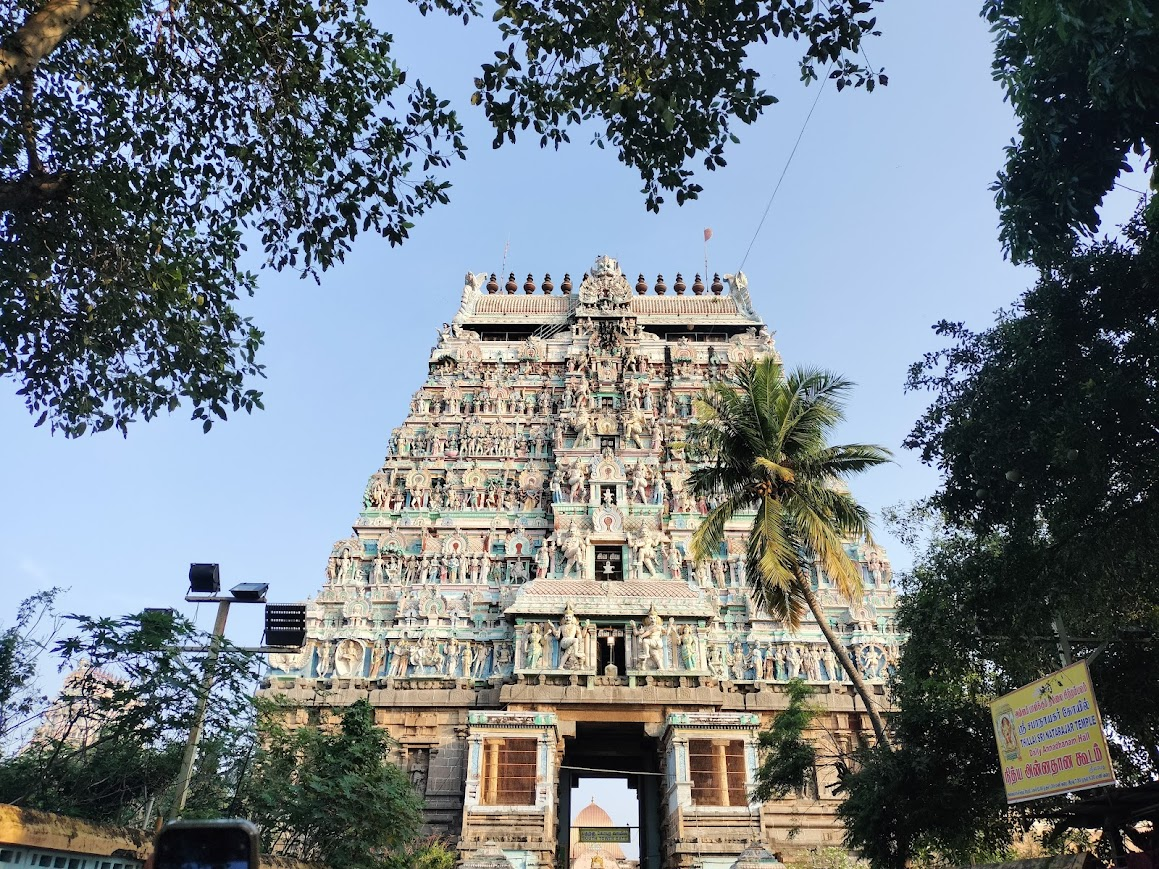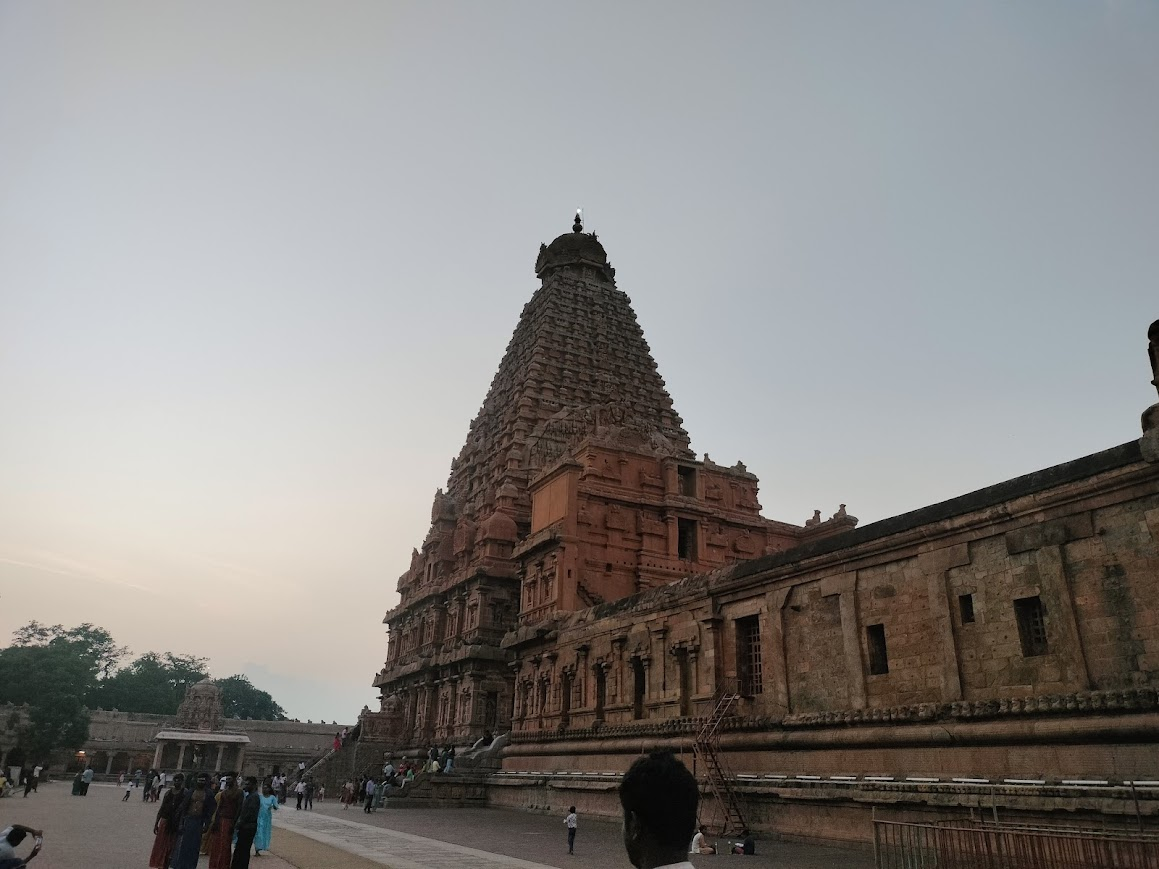We overslept a bit. We were supposed to be up at 4:30am and to watch the day's first sunlight from inside the temple. By the time I came to, it was 5:30 already and my friends were all fast asleep. We woke up one by one and got ready by around 6:45.
Hurrying to the temple, we saw the magnificent icon of Garuda first, flanked by murtis of Angada and Sugreeva. This huge Garuda is in a sitting position with his palms anjalibandham. The idol is always wrapped in a white dhoti from the waist down. We then proceeded inwards to receive Namperumal's darshanam. Passing through the many prakarams of the temple, we finally saw Namperumal in the company of his consorts, Lakshmi Devi and Bhumi Devi. They are a sight to behold.
The legend of Srirangam
Stepping outside the Gayatri Mandapam, we worshipped the vimanam, itself called the 'Ikshvaku Kula Dhanam'. The Rangavimanam was the vehicle in which Narayana appeared to Brahma at the beginning of creation. Brahma circumambulated the Rangavimanam chanting the four Vedas. The story goes that it was Ikshvaku, the ancestor of Sri Rama, who brought the Rangavimanam from heaven onto the earth. Many generations later, after the Rama-Ravana war, Sri Rama gifted the Rangavimanam to Vibhishana and asked him to take it back to Lanka, of which Vibhishana had just become king. Passing through Bharatavarsham, Vibhishana stopped at the banks of the Kaveri to perform the 'ucha puja' (afternoon puja) on the vimanam.
Chola legend says that one of the Adi Chozhas, Dharma Varman, asked Vibhishana for permission to conduct a grand festival to celebrate the vimanam's coming to Chozha Nadu. He agreed, but at the end of the 12 day utsava, Vibhishana found that the vimanam would not move from its place. Ranganatha Swami appeared to him and told Vibhishana that he wished to stay on the banks of the Kaveri and instructed Vibhishana to return to Lanka. He did so, and Dharma Varman constructed the first structures of the Srirangam temple, placing the vimanam on top of the temple. Out of love for Vibhishana, the main deity faces the south in this temple, quite uncommonly.
After our darshanam of Namperumal, we went to the various sub-sannidhis in the temple. We first visited the sannidhi of Annamurti. Then came Kampathadi Anjaneyar, a manifestation of Hanuman.
Azhwar Mahatmyam
Stepping outside the innermost prakaram, we went to the shrine of Madhurakavi Azhwar, the author of the Kanninun Siruthambu. In this shrine there were three icons. In the centre was Sathagopan, that is, Nammazhwar, and on his right side was his dasan, Madhurakavi Azhwar. On his left stood Thirumangai Azhwar.
The Azhwars, for those unaware, are 12 highly realised souls who sang of the glories of Mahavishnu in Tamil. In total, they sung about 108 kshetrams, which are now called the Divya Desams of Vishnu. Most of these are in Tamil Nadu and Kerala. Foremost among the Azhwars is Sathagopan, or Nammazhwar, who was born deaf and mute but was given hearing and speech by the Lord upon meeting his disciple, Madhurakavi Azhwar. Sathagopan went on to translate the Samavedam into Tamil, calling it the Tiruvaymozhi.
Madhurakavi has sung only 11 hymns (pasurams) of the total of 4000 of all the Azhwars. Yet he is accorded a special place among them for a single reason. Unlike the others, Madhurakavi Azhwar did not sing of Mahavishnu directly or of any grand temples. His pasurams are all about his teacher. He saw God in Sathagopan and dedicated himself entirely to his service. Madhurakavi is therefore the epitome of gurubhakti. Recently, his 11 pasurams have been put to music in an incredibly beautiful way by the Perumal and Providence project along with Ashwath and Sumesh Narayanan.
Other sannidhis
At the southwestern corner is the shrine of Chakrathazhwar. This is none other than Sudarshana Murti, the disc of Mahavishnu. Behind Sudarshana Murti stands the ferocious Yoga Narasimha, the Adiyogi in Vaishnava tradition.
On the western side of the fortifications one can see the Vasanta Mandapam of Namperumal. It was closed to the public at the time of our visit. It consists of a beautiful garden and a stone mandapam.
On the northern side are temples to Thayar (Ranganayaki), Narasimha and others. We worshipped at both.
There is a special game you can play near the temple of Venugopala here. Standing at a marked position, you are supposed to bend over and insert the fingers of your right hand into five holes in the floor. If you can see the Paramapada Vasal (a gate into the main temple) of Namperumal while standing in this position, you are apparently eligible for moksham!
On the eastern side one can see shrines to Kodandapani, Pattabhirama and Balagopala. At the southeast corner is the shrine of Ramanujacharya, where his mummified udal is kept to this day.
Amazed at what we had seen, we had forgotten all about food and water. By then it was past 9am and we were ready to eat. Over dosas and filter coffee, we decided to visit the Rock Fort temple in Trichy next.
Malaikottai—Thayumanavar and Uchipillaiyar
This is perhaps the oldest structure in the city of Tiruchirapalli. Malaikottai is a giant rock monument consisting of a number of shrines. Leaving our stuff at the bottom, we slowly climbed upwards through the inside of the rock-cut fort.
The most well-known shrine in this complex is that of Thayumanavar, or Matrubhuteswara. He is an aspect of Sadashiva. The story goes that Shiva appeared in disguise as a woman's mother to be a midwife for his devotee, who was stranded on the wrong side of the Kaveri when her water broke. Hence Thayumanavar—'he who also became a mother'. He dwells here in the company of Sugandhi Kuntalambal, Parvati.
The summit of the hill is a temple to Ganapati, called Uchipillai here. This is also connected in some way to the episode of the establishment of Srirangam. I am not sure of the exact sthala charitram.
Closing notes
I never imagined this journey to be possible. The initial idea to visit Chidambaram occurred to Neeraj and me in November, when we visited Kanyakumari and were standing at the ticket counter on our way back. I wanted to go right then as a spontaneous trip, but Neeraj recommended that we plan a bit and go later, with more people. That was a good idea.
Eventually, we saw that returning to Kerala from Chidambaram was not possible without an exchange train. I suggested Srirangam for an exchange, and so we fixed that. Basil said he wanted to visit Thanjavur, increasing the number of destinations to four.
My first darshanam of Thillai Chidambaram is something I vividly remember down to the last detail. The incident was like Vishnu leading me to Paramashiva. It spoke to me at a spiritual, personal level.
We know of many preachers and religious scholars today who bring their respective ideas to the masses through speeches and writings. I have little faith in them. To me, God is a deeply personal experience. It is impossible to talk about God when the speaker and listener have no emotional connection with each other. It is only through love, the strongest and most fiery emotion, that one man can talk to another about God. I think this is precisely what we experienced during this journey, and I am very grateful for it.
With Uchipillaiyar's darshanam, our teerthatana had come to an end. It was a weekend like no other, and one that we will keep talking about for a while.
Until next time,
Om Namo Narayanaya 🙏
Aravindan


















